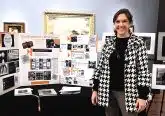Deaf Ministry: Newly-Formed Archdiocesan Office for Persons with Disabilities Seeks to Make the Sacraments More Accessible
 Imagine being a Catholic in need of confession but being told no priests in the area speak your language. Consider the same scenario for weddings and baptisms. Would you feel welcome as a parishioner if your entire sacramental life were administered through interpreters?
Imagine being a Catholic in need of confession but being told no priests in the area speak your language. Consider the same scenario for weddings and baptisms. Would you feel welcome as a parishioner if your entire sacramental life were administered through interpreters?
Such is the life of deaf Catholics in the Archdiocese of Cincinnati.
Noelle Collis-DeVito, associate director for the archdiocese’s Office for Persons with Disabilities, wants to change that. Collis-DeVito, and office director Bob Wurzelbacher, have operated the newly-formed office since May. Kara Ross of the Respect Life Office also assists. Their spectrum of focus is wide, and some early efforts are focused on the Deaf Community.
“Our goal is to meet the needs of people from across the spectrum of disability: mental health, the deaf community, the blind community, people with developmental and intellectual disabilities, people with Autism and people with physical disabilities,” Collis-DeVito said.
One reason for the focus on the deaf community is a dearth of priests available to celebrate the sacraments in American Sign Language (ASL). The archdiocese, which consists of more than 200 parishes, had just two priests capable of doing so in recent years. One is now deceased, and the other has retired and moved away. The office is working to see local seminarians trained in ASL and, in the meantime, will bring in deaf priests from around the country quarterly.
“There are now no priests in the archdiocese who can provide the sacrament of reconciliation for the deaf community,” Collis-DeVito said. “We’re working with a team of people to try and correct that and do what we can to provide opportunities for that sacrament and for all of the sacraments in their native language, because you don’t want to get married with an interpreter, or have your baby baptized with an interpreter. It’s been a great opportunity to envision what a church that’s welcoming to the deaf community would look like.”
Collis-DeVito said the Office for Persons with Disabilities doesn’t have statistics on how many deaf Catholics reside in the archdiocese. St. Rita School for the Deaf reports that approximately three in every 1,000 babies nationwide are born with permanent hearing loss. The deaf community extends beyond those with total hearing loss. It also includes the hard-of-hearing, people who have an impairment, people with cochlear implants and children of deaf adults.
Collis-DeVito said that only three percent of the deaf community go to church at all, and only one percent of those are Catholic.
“The interesting thing about the deaf community is it’s really its own culture,” she said. “They have their own language and cultural norms and media. There’s just a general feel for what it’s like to be deaf. They take pride in that, and they don’t really see being deaf as a disability; it’s just that they can’t hear.”
St. Rita School for the Deaf has long been a staple of deaf outreach in the archdiocese and is funded by the Catholic Ministries Appeal each year. Several members of the St. Rita staff are on the Office for Persons with Disabilities task force.
Other efforts on the horizon for the new office is resuming sensory-friendly liturgies for persons with autism, other disabilities and even Alzheimer’s disease, fighting the stigma associated with mental health issues and building a catechetical, individualized education program for children with various disabilities.
“People want to be known for who they are and not for their disability,” Collis-DeVito said. “Their disability is just a part of who they are.”
Learn more about the Office for Persons with Disabilities by following them on Facebook at facebook.com/cincinnatiOPD.
This article appeared in the March 2021 edition of The Catholic Telegraph Magazine. For your complimentary subscription, click here.















